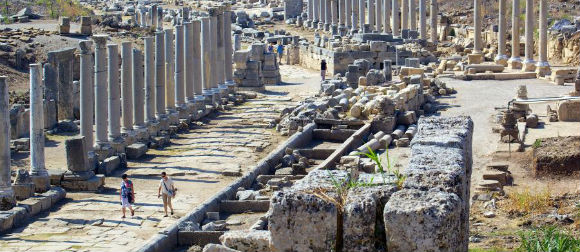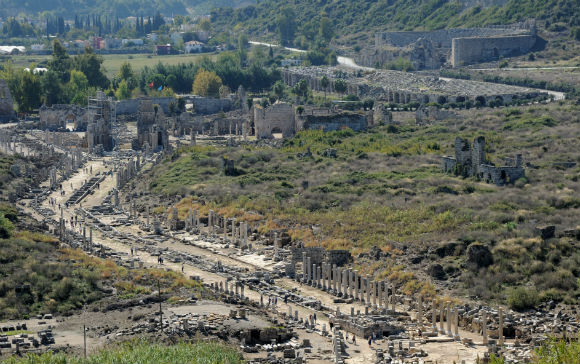The most impressive ruins of the Pamphylian coast are at Perge, at about 15 km east of Antalya. Perge was originally founded by the Hittites around 1500 BC. and was known as Parha. It was a successful trading centre near the Aksu (ancient Kestros or Cestrus) river when Alexander the Great arrived in 333 BC. He was welcomed in by the inhabitants and used Perge as base for his Anatolian campaigns. Alexander was followed by the Seleucids under whom the city prospered and Perge’s most celebrated inhabitant, the mathematician Apollonius from Perge lived and worked. Apollonius was a pupil of Archimedes and wrote a series of eight books on geometry. In 188 BC Perge became part of the Roman Empire during which the city flourished. Most of the surviving buildings date from this period.In 46 AD St. Paul started his journey in Perge (biblical Perga) and preached his first sermon here. Perge gradually declined during the Byzantine period, as the Aksu river silted, but remained inhabited until Selçuk times after which it became abandoned.
A visit to Perge starts by entering the archeological site through the Roman Gate, built during the reign of Septimius Severus (193-211 AD). Proceeding through the gate, to the right is the Agora or market place. This structure of 75 x 75 m dates back from the 2nd century AD. The center courtyard and shops were surrounded by a wide stoa, a covered walkway. The floor of the stoa and shops was made of colored mosaics. The agora was not only the centre of Perge’s trade, but was also a place for meetings as well as a forum for political, social, and philosophical discussions. The next building is the Hellenistic city gate that dates back to the 3rd century BC. This is certainly the most imposing building of the city and was cleverly designed to protect the city with its twin towers and its horseshoe-shaped courtyard at the back. It is thought that the towers had three floors and were crowned by a conical roof. In the year 121 AD, the horseshoe-shaped courtyard was rededesigned as a courtyard of honor. Behind the courtyard stood a triple arch. Around the arch there are about dozen inscriptions connected with Plancia Magna who lived in the 2nd century AD. She was the daughter of the governor, a priestess of Artemis Pergaia (Diana) and a benefactress to the city. Plancia Magna had the arch decorated with the statues of the emperors and their relatives.
After passing through the Hellenistic Gate and courtyard, one enters a broad, marble-paved double-colonnaded street measuring 300 meters in length that extends from the main gate to the acropolis. The street is 20 m wide and is divided in two by a 2 meter wide water channel running down the middle. At the end of the colonnaded street is the Nymphaeum, a triumphal fountain from where a stream flowed down into the water channel. The nymphaeum or nymphaion is an ornamental semicircular structure and dates from the reign of Emperor Hadrian (130-150 AD). A statue of a river god Kestros was located in the center of this huge fountain. Behind the nymphaeum is the acropolis with some remains of the Byzantine period. To the west of the nymphaeum are the remains of a palaestra dating from 50 AD and dedicated to the Emperor Cladius (41-54 AD).
Returning back to the entrance, there are the excavated Roman baths located southwest to the agora. Out of the site proper, is the horsehsoe-shaped stadium, the largest in Asia Minor, measuring 234 m by 34 m. The stadium had a seating capacity of 12,000 people supported by massive barrel-vaulted constructions. Just beyond the site entrance is also the theatre, which is of the Greco-Roman type and could seat 15,000 people. Unfortunately, it is for some time under reconstruction and unfortunately closed to visitors.
Perge,



Liked – Lots to see, cheap, and easy to get to from Antalya. Great views from the athletics stadium.
Disliked – The ampitheatre is still being excavated and the entry to the athletics stadium is hidden under the arches
I was so impressed with this archaeologist site one of the best visited. Well laid out and signposted.you really get a feel for life in the past. Visited Hampi in India and whilst smaller compared town life across the continents.
I consider this as a must to see, when visit Antalya or Belek, particularly if you are curious about the Roman and Greek history, and the interaction with the Turkey in the past. The ruins was well maintained and preserved. The acropolis is still in the excavation, but the pillars, ruins of roman bath, and the market street can easily…
If you are travelling along the coast in Turkey, you will come across many ruins, but Perge is one of the top spots. The place is quite large, there are well preserved ruins aplenty and it's a thrill to be able to walk anywhere without any restrictions. Be prepared to suffer from the heat, though (especially in the summer), as…
This is the same Perga (alternate name) described in the book of Acts as one of the apostle Paul's destinations. But for those not interested in Biblical history, this is still an extensive and accessible site, full of interesting architecture to explore up close.
This was a fairly easy drive from Antalya. About 30 minutes and well signed.
What a fantastic location themthar Romans certainly knew how to build. A good guide is essential and ours(Erim) was definately worth his salt he painted a thorough picture of what it was all about.
we had a day trip out ,full of history amazing place ,if you like historic go here .take sun cream very hot and lots water.
nice day out, went with thomas cook english tour which gave us a good undersatnding of the history of perge. just wear comfortable shoes!
Take lots of water, very hot, but really worth it!
If you like these, you'll love Side, check it out.
An extremeley impressive well preserved site and certainly worth a trip to see.